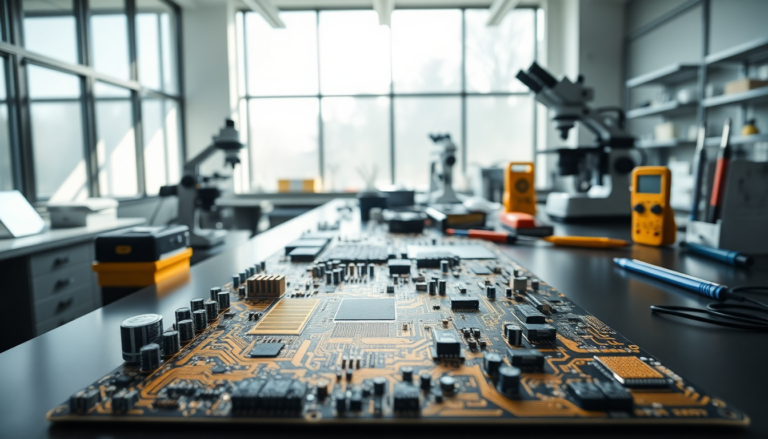Argomenti trattati
In the ever-evolving world of gaming, staying ahead of the curve means constantly rethinking how we approach printed circuit board (PCB) technology. With the gaming industry gearing up for some serious advancements, it’s essential to understand the future trends in gaming console PCB design. This knowledge is crucial for crafting systems that can keep pace with what today’s gamers expect. Let’s dive into the latest market trends and technological innovations that are reshaping the engineering of gaming consoles.
Understanding the Demand for Advanced PCB Technology
The gaming industry is booming, with projections estimating its market value to hit a staggering USD 61.2 billion by 2033. This growth highlights the rising expectations from gamers for lightning-fast load times, breathtaking graphics, and smooth multiplayer experiences. So, how do designers meet these demands? The answer lies in developing PCBs that can handle high-speed data transfers and complex functionalities. Future-proofing these designs is becoming essential to ensure that consoles can adapt to new technologies and remain relevant in a fiercely competitive market.
But what does future-proofing really involve? It’s all about anticipating trends like the need for higher processing speeds and improved thermal management. As gaming consoles grow more sophisticated, we’re seeing innovations such as artificial intelligence and cloud streaming becoming standard. By understanding these trends, designers can create PCBs that not only satisfy today’s requirements but are also primed for upgrades down the road.
Key Trends Influencing PCB Design in Gaming Consoles
As we step into the next generation of gaming consoles, the demands on PCBs are skyrocketing. They must now support data transfer rates exceeding 10 Gbps—a necessity for features like 8K resolution and real-time ray tracing. High-speed signal integrity is crucial to prevent data loss and interference. To tackle this, designers are focusing on techniques that reduce signal crosstalk, such as optimizing trace layouts and using materials with low dielectric constants. These strategies are key to delivering the high-performance gaming experiences that players crave.
Additionally, with gamers seeking sleeker and more portable consoles, the adoption of High-Density Interconnect (HDI) technology is on the rise. HDI enables a greater number of components to be packed into smaller spaces, which is vital for housing powerful GPUs and CPUs without compromising performance. This trend also supports multi-layer boards, making complex routing possible while keeping designs compact.
Thermal management is another critical player in PCB design. High-performance processors generate a lot of heat, making effective thermal management essential to prevent throttling and system failures. Today’s designers are incorporating advanced thermal vias and materials that enhance heat dissipation, ensuring that components remain within safe operating temperatures, even during those intense gaming marathons.
The Role of Sustainability and Innovation
With a growing consciousness about the environment, the gaming industry is increasingly embracing sustainable practices in PCB manufacturing. The shift towards halogen-free laminates and lead-free soldering materials is becoming the norm. Some manufacturers are even exploring bio-based resins for PCB substrates, significantly reducing carbon footprints. This trend reflects a broader movement within the industry to balance high performance with eco-friendly design.
Innovation is also shaking up traditional PCB design approaches. The rise of 3D-stacked architectures allows for greater component density and reduced signal latency. By vertically integrating multiple layers or separate boards using through-silicon vias, designers can create more powerful and efficient gaming systems. Flexible and rigid-flex PCBs are gaining ground too, enabling the creation of portable gaming devices that can adapt to unconventional shapes.
As the gaming landscape continues to evolve, the integration of artificial intelligence and Internet of Things (IoT) features into consoles demands advanced circuitry and sophisticated power management systems. To support the always-on connectivity required for AI-driven experiences, designers must build robust power delivery networks and secure communication protocols right into their PCB layouts.
Practical Applications of PCB Innovations
To stay ahead in the fast-paced world of gaming console PCB design, it’s crucial to translate these insights into practical applications. Start by selecting materials wisely—opt for high-frequency laminates with low loss tangents for those high-speed applications. When it comes to thermal management, choose substrates with high thermal conductivity and consider integrating copper inlays for optimal heat dissipation.
Moreover, optimizing layouts for performance is vital. Use simulation tools to model signal integrity and thermal behavior before production, ensuring controlled impedance routing is in place. And don’t forget to plan for scalability; designing with modularity in mind will allow for future upgrades without requiring complete redesigns.
Finally, keeping up with industry standards and advancements will empower designers to adapt to new technologies and practices. By embracing these trends and innovations, designers can create gaming console PCBs that not only meet current demands but also anticipate future needs, securing their products’ place in a rapidly evolving market.

